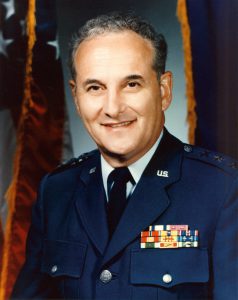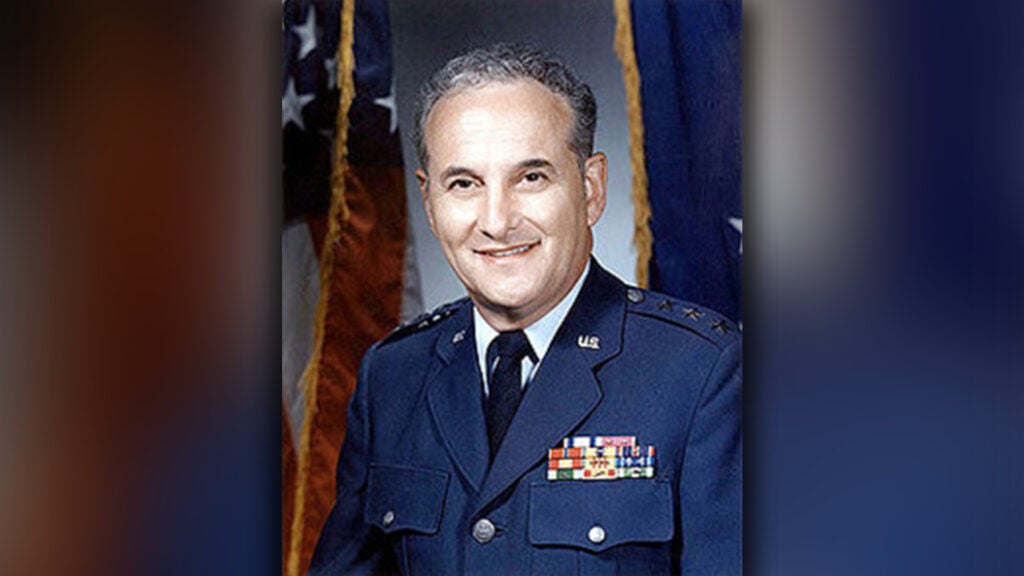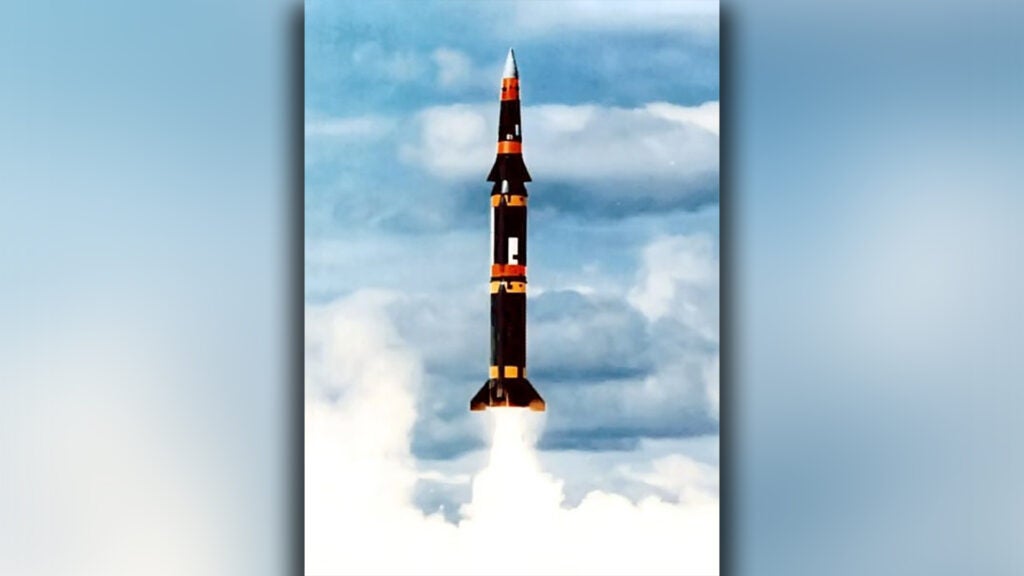Perroots wrote, “it is not certain that we looked hard enough or broadly enough for information…For Western collectors the context was peacetime without even the most basic ripples of crisis. For the Soviets, however, the view may have looked quite different.”
In a 1989 memo, CIA officials admitted that Perroots’ letter surfaced “a long standing warning problem, i.e. the need for the intelligence community in Washington to provide more timely, discriminating and accurate warning in support of the theater commander.”
By: DAVID ROZA | taskandpurpose.com FEBRUARY 23, 2021

Lt. Gen. Leonard Perroots was on the intelligence desk for U.S. Air Forces Europe on Nov. 5, 1983, when he heard that Soviet Air Forces in East Germany were on high alert and being loaded with munitions. The Air Force officer called his boss, Gen. Billy Minter, who asked Perroots if they should load up for war in response.
“I said that we would carefully watch the situation,” Perroots later wrote in a letter to senior U.S. intelligence officials, “but there was insufficient evidence to justify increasing our real alert posture.”
Little did Perroots know, he had just played a crucial role in averting what could have resulted in armageddon, had the nuclear-capable war machines of both the North Atlantic Treaty Organization and the Soviet Union continued to spin up. Experts later compared the incident, now known as Able Archer 83, to the 1962 Cuban missile crisis in terms of how close both sides came to declaring war.
At the time, the Soviet Air Forces were reacting to NATO military exercises in the region, but when they saw NATO did not escalate further (as a result of Perroots’ recommendation), the Soviet military backed down as well, thereby avoiding a possible war.
“He chose not to escalate Western forces in response, and essentially that ended the escalation,” said national security expert Nate Jones, who wrote a book about Able Archer 83. “The quote is [he] ‘either out of ignorance or luck’ ended the danger.’”

Now, a new letter released this month by the State Department reveals just how much we owe Perroots for following his instinct not to escalate. The letter, written by Perroots in 1989 to senior U.S. intelligence officials, criticizes the intelligence community for not tracking the incident more closely at the time and for not keeping NATO commanders more informed of developments in the Soviet Union.
“Our problem here was that we had a couple of very highly classified bits of intelligence evidence about a potentially disastrous situation that never actually came to fruition,” wrote Perroots, who sent the letter right before retiring as head of the Defense Intelligence Agency. “What might have happened that day in November 1983 if we had begun a precautionary generation of forces rather than waiting for further information?”
By the fall of 1983, the Soviet Union had become increasingly paranoid of any signs of aggression from NATO, according to a history of Able Archer 83 written by the Atomic Heritage Foundation. In March of that year, President Ronald Reagan, a hardline anti-communist who heightened Cold War tensions after a decade of détente, seemed to spike that tension further after calling the Soviet Union “the focus of evil in the modern world.”
That, in addition to Reagan’s new Strategic Defense Initiative and the deployment of Pershing II missiles to West Germany, had top Soviet officials convinced that NATO was planning a nuclear strike. In a bit of self-fulfilling prophecy, those officials then directed their intelligence agents to aggressively collect any information that would indicate a strike.
The result, according to legendary KGB defector Oleg Gordievsky in his autobiography Next Stop Execution, was “a vicious spiral of intelligence-gathering and evaluation, with foreign stations feeling obliged to report alarming information even if they did not believe it.”
While both NATO and the USSR were paranoid of a nuclear strike throughout the Cold War, NATO was not aware of how much more paranoid USSR had become when NATO ran its annual Autumn Forge training exercise in 1983.
The exercise, where NATO forces practiced defending against a Soviet invasion of Europe, involved 100,000 troops and six smaller exercises, one of which was Able Archer. Able Archer was a high-level exercise where headquarters staff practiced the transition from commanding conventional forces to using nuclear weapons. Still, when the USSR detected new procedures and message formats used in the 1983 edition of the drill, it further convinced the Soviets that something was afoot on the other side of the Iron Curtain.
“New launch procedures, practicing new missiles, and at the same time [Soviet] intelligence was reporting these indicators as possibly real,” Jones said. “They readied their nuclear forces in response. Western intelligence saw ‘hey, what’s going on here?’ It got all the way to the president and the warning signs were raised.”
As Soviet bombers in Poland and East Germany were loaded with bombs and as Soviet submarines dived beneath the Arctic ice, the cogs of the war machine began to take on a momentum of their own, Jones said. But U.S. officials remained unaware of how strongly the Soviets were reacting to Able Archer 83, the Atomic Heritage Foundation wrote. In fact, American officials admitted as much in a 1990 report on the incident by the President’s Foreign Intelligence Advisory Board.
“We may have inadvertently placed our relationship with the Soviet Union on a hair trigger,” the report said. “The U.S. intelligence community did not at the time, and for several years afterwards, attach sufficient weight to the possibility that the war scare was real.”

And who got the intelligence community to admit that failure? Our friendly neighborhood airman Lt. Gen. Leonard Perroots, whose 1989 letter spurred officials to take a closer look at what happened that fateful autumn of 1983.
“Perroots’ letter sparked a full, all-source investigation by the President’s Foreign Intelligence Advisory Board, culminating in its highly secret 1990 report “The Soviet ‘War Scare,’” wrote George Washington University’s National Security Archive in an announcement on Feb. 17. The report was declassified in 2015, after a 12-year legal struggle with the U.S. government, but Perroots’ letter was not released until earlier this month. The 1990 report applauded Perroots for avoiding a possible nuclear apocalypse.
“Following the detection of the Soviet Air Forces’ increased alert status, it was his recommendation, made in ignorance, not to raise US readiness in response — a fortuitous, if ill-informed, decision given the changed political environment at the time,” officials wrote.
Gordievsky, the legendary KGB defector, was still in the KGB when Able Archer 83 unfolded. After he escaped from Russia in 1985 (which is an insane story all by itself), he told U.S. intelligence officials just how freaked-out the Kremlin was during Able Archer 83. That testimony, plus information from British signals intelligence and some U.S. assessments, really pissed Perroots off.
“For the next six months I was on a soapbox about Able Archer whenever I could discuss it at the appropriate classification level,” the general wrote in his 1989 letter. “I buttonholed a lot of people.”
The airman was mad because it was “not certain that we looked hard enough or broadly enough for information,” he wrote. “For Western collectors the context was peacetime without even the most basic ripples of crisis. For the Soviets, however, the view may have looked quite different.”
In a 1989 memo, CIA officials admitted that Perroots’ letter surfaced “a long standing warning problem, i.e. the need for the intelligence community in Washington to provide more timely, discriminating and accurate warning in support of the theater commander.”
“His candor is a safeguard against complacency and denial that problems exist,” they added.
Perroots passed away from complications of Parkinson’s disease in 2017 at the age of 83, according to his obituary in the New York Times. His son, Len Perroots Jr., told the Times he was proud of his father’s decision, saying that the judgment was neither impulsive nor arbitrary.
“The bottom line was, he put his career on the line by not doing anything,” he said. “He made that decision based on the ideals he carried with him his whole life.”
Few of us will ever encounter a decision as heavy as the one Perroots had to make, but there is still something we can all take away from it, which is his spirit of self-reflection. After all, CIA officials noted that the airman had “buttonholed” them not because he had made the right judgment, but because he feared he made it for the wrong reasons, considering the incomplete information he had at the time. Perroots still seemed to be wrestling with that paradox when he wrote his 1989 letter.
“[I]f I had known then what I later found out, I am uncertain what advice I would have given,” he said.
